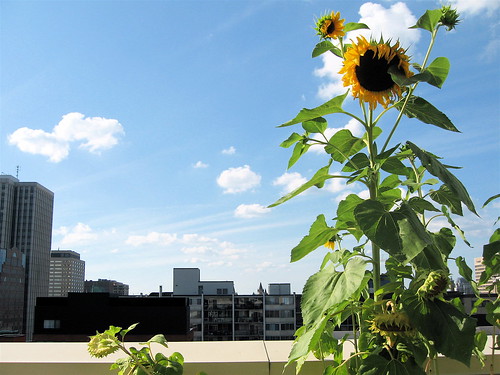
Our Centretown condo has a community garden with a view; it looks out over the downtown skyline 11 stories above the street.
Each weekend my husband and I go up to our roof and tend our patch. We greet Ann and ask about her tomatoes. We marvel at Dave’s sunflowers that have bloomed bright yellow. There’s recipe swapping, and lots of helping hands. Ten percent of our building’s residents –seniors, students and young professionals– are now gardening on the roof.
One of the designed features of our 2-year old downtown condo was a roof-top terrace. On taking possession of the building, the condo Board started a garden committee almost immediately. In one of its first meetings, it identified an unused space — originally planned to be a large pergola area on the roof — as a possible community garden. It seemed a perfect use, and so it has turned out to be. Yet when we look out from our lofty patch of green, all we see is black wasted space. Spaces perfect for planting. If that sounds like the top of your building and you’d like do something with that space, here is what we’ve learned.
Rooftop Gardens 101
First you have to have your rooftop fitted for drainage and plant-growing, if you want to water and plant a flat space. If this proves impossible, look into the exciting things people are doing with potted gardens.
Second, strike a garden committee. Designate a community garden organizer who reports to the committee. The organizer’s role is to divide and distribute plots, purchase any communal gardening needs (i.e. soil, mulch, hose), and liaise with the gardeners, reminding them to weed and tend their plots.
You will need a shed or nook for communal tools and a small budget, which comes from the garden committee. Rooftop BBQs are perfect fundraisers for the committee’s budget!
The rest is up to the gardener. You put in the time, plant the plants and taste the rewards.
Support for Community Gardens
There will be naysayers.
Last year our garden struggled with a rainy summer and late start to the planting season. The garden saw a poor yield and low enthusiasm. Matters worsened when some complained about the aesthetics and the loss of the well-manicured landscaped look.
This season, however, things have changed. Two years in, the gardeners are more committed. Different sized plots were offered. An early start to the growing season and plenty of sunshine has seen the garden explode with vegetables, flowers and herbs. Skeptical neighbours now realize the potential of the community garden and we’ve had a groundswell of fresh support.
Community and Food Security
Perhaps the best part of community gardening is not the plants, but the sense of community.
Our neighbour Ann, who owns one of the condos without a balcony, was eager for some green space of her own. Instead, she got to meet and get to know other neighbours she wouldn’t necessarily have had the chance to get to know as a retired resident. She doesn’t ride the elevator at 9 or 5, but now she can chat to Alex, a young arts worker, about his lettuce and beets.
Despite the density, living downtown can still be lonely for some people. Condos can be especially isolating; that’s why communal areas such as party rooms, bike storage, libraries, pools and recreation facilities are in high demand as amenities. But gardening is more than a building feature. It’s a way to connect and get to know your neighbours throughout an entire season.
Harvesting even so much as a single pepper over the course of the summer also makes urbanites mindful of what it takes to stock the shelves at nearby Hartman’s. None of us take that for granted anymore; support for initiatives that plan urban space to include better food security starts from just such a realization.
photo by Kate Wetherow

2 comments
Wonderful story. Urban planners take note! We need infrastructure and building codes that will promote this kind of thing. Thanks for sharing this.
What a great article Kate, your enthusiasm is refreshing. It wasn’t the builder, the city or other public bodies responsible for this great space, but the condo owners who nurtured and took ownership of their own space, great to see.